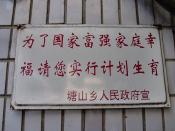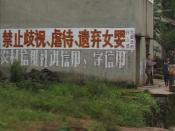The vast population increase over the past few decades has been a reason for concern worldwide. However, a small number of countries have responded in the way China has. The population growth has put pressure on the country's limited resources. Many people are moving to the cities, leaving less people to cultivate the lands. Not only is the population increasing, people are living longer. In order to prevent china's explosive population increase, the government implemented the policy known today as "China's One-Child Policy", in 1979.
The one-child policy does not mean that all families are obligated to have only one child. Some formal exceptions are drawn to this policy. First, ethnic minorities are officially excluded from the policy, although some have reported being forced to obey. For example, Tibet and some other ethnic minorities are allowed to have more than one child. Manchu have been allowed to have two children, Hui have been allowed to have four, and Tibetans can have as many as they want.
Recently, Han, living in the countryside that has a female child first are allowed a second chance to have a male child. However, if you are in the larger cities and are a Han, the one child policy is still generally pretty strict. Having traveled in China, I have seen first hand just how crowded the cities really are, there is no space over there. The broad open spaces we take for granted in Canada don't exist over there due to the amounts of mountains and deserts there. Second, if both parents are only children, they are allowed to have more than one child provided the children are spaced more than four years apart. Third, families who have children with mental or physical disabilities are sometimes permitted to have a second child.


